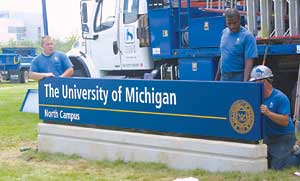Like a big empty garden, U-M’s new North Campus Research Complex — the former Pfizer property — is 174 acres of fertile ground ready to be planted with seeds of research opportunity.
University officials hope to grow the massive, 30-building complex into a center for innovation, housing cutting-edge research and interdisciplinary teams of scientists. The university closed on the $108 million purchase in mid-June, taking possession of about 2 million square feet of laboratory and office space, located near Plymouth Road and Huron Parkway.

“What this represents is the opportunity to transform the university’s approach to research,” says Dr. James Woolliscroft, chair of the Director’s Committee for the North Campus Research Complex and the person President Mary Sue Coleman has tasked with leading the site planning.
“This is a springboard to creativity,” says Woolliscroft, dean of the Medical School. “It is such a great opportunity to set the stage as a leader, globally, in what can be done at a research-based institution.”
Committees with campuswide representation — including faculty and staff from the Medical School, pharmacology, public health, engineering, dentistry, nursing, business and LSA — are brainstorming how the property should be developed. Business and government leaders from outside U-M also have joined in the discussion.
“We are looking at the whole structure as a big draw to educate and train innovators,” says Mark Burns, chair of chemical engineering in the College of Engineering. “I’d like to see researchers from many different disciplines move out here to NCRC to work together on complex problems.”
The university purchased the property as is from Pfizer, which included furniture and laboratories. About 1,500 parking spaces are on the property. Pfizer moved out after a January 2007 decision to consolidate its research operations in other company locations.
Up to 3,000 new faculty and staff positions could be created in the next 10 years at the campus, now dubbed NCRC. It also will provide much needed space for current research and attract new projects and faculty to U-M, which now is the fifth-largest research university in the nation.
|
“The type of research to be included in this new facility is broadly conceived, but we anticipate it will include a range of disciplines that will benefit from being located together within the research complex itself,” says Stephen Forrest, vice president for research. “For example, considerable research will focus on, but not be exclusive to the biomedical fields. Also, space will be dedicated to partnerships between U-M researchers and those in the private and governmental research sectors.”
The new campus could have some tenants as soon as late 2009. If the university had begun planning a new research building of comparable size today, the earliest it could be occupied would be 2014 and the cost would have been many times greater.
Woolliscroft plans a carefully considered process for occupying the buildings. Currently being explored are a center for health care policy and innovation, drug discovery efforts, a specialized neuroscience institute, incubator space for faculty and a technology park to attract partnerships with government and business.
Woolliscoft says the center will draw on the expertise of departments campus wide.
“We will not rush to fill the space,” he says. “This is a unique opportunity to rethink how we bring teams of investigators from across campus together in ways that will enhance discovery and collaboration.”
One of the strategic planning committees is charged with reviewing how the university should foster innovation.
“We don’t want to just move what we’re doing and do more of it,” says Dr. Max Wicha, director of the Comprehensive Cancer Center. “We really have to do something different … create new things and deliver them.”
The potential is huge for the university to go where we have not gone before, says Steven Kunkel, senior associate dean for research and endowed professor of pathology.
“We need to be bold and seed the future … move into revolutionary new areas,” Kunkel says. “The acquisition of this site fits with one of our core missions: research. It supplements our proven strengths.”

